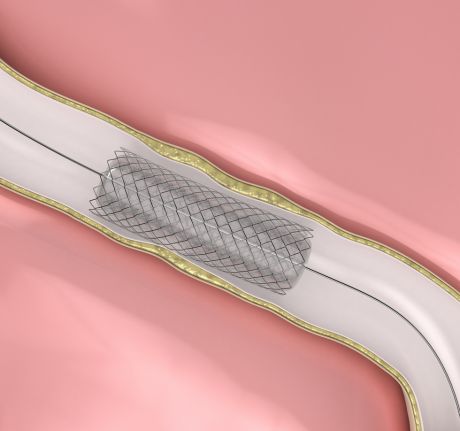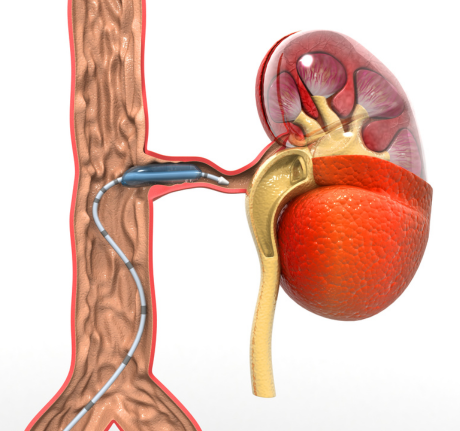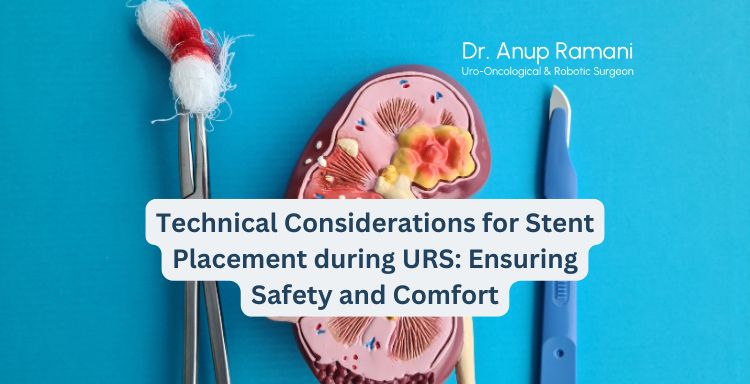Dr Anup Ramani @ Copyright 2024
By Dr. Anup Ramani
Kidney stones can cause excruciating pain and, if left untreated, can lead to severe complications. One of the most common procedures for removing kidney stones is ureteroscopy (URS), a minimal invasive surgery that involves using a scope to remove stones from the kidney or ureter. During URS kidney stone removal, a stent is often placed in the ureter to keep it open and promote healing after the procedure. However, the placement of the stent is not a straightforward task. There are several technical considerations that need to be taken into account to ensure the safety and comfort of the patient during and after the procedure.
In this article, we will explore the technical considerations involved in stent placement during URS. We will focus on how these technical decisions influence the success of kidney stone removal surgery, the patient’s recovery and the overall comfort during the process.
Understanding Ureteroscopy and the Role of Stents
What is Ureteroscopy (URS) for Kidney Stone Removal?
Ureteroscopy is a commonly performed procedure used to remove kidney stones located in the kidney or ureter. The procedure is minimal invasive and does not require large cuts, making it a preferred choice for many patients. It involves inserting a small camera (ureteroscope) into the urinary tract through the urethra and bladder to reach the kidney or ureter, where stones are identified and removed using specialized tools.
In most cases, kidney stone ureteroscopy is followed by the placement of a stent in the ureter to maintain an open passage for urine flow and to prevent any obstruction that may occur during healing. The stent is a thin, flexible tube inserted into the ureter to help it stay open and ensure proper urine drainage.
Why is a Stent Necessary after Ureteroscopy?
The placement of a stent is often necessary following kidney stone removal to:
- Promote Healing: The ureter may become swollen after the procedure. The stent keeps it open, reducing the risk of complications like infection or scarring.
- Prevent Obstruction: After removing kidney stones, there is a risk of blockages forming due to swelling or leftover fragments. The stent ensures that urine can flow freely from the kidney to the bladder.

- Manage Pain and Discomfort: Although stents are generally helpful, they may cause some discomfort. Proper placement and aftercare can minimize pain and complications.
Common Challenges in Stent Placement during URS
While stent placement is routine in kidney stone removal by surgery, it involves several considerations to ensure patient comfort and reduce the likelihood of complications.
Technical Considerations for Stent Placement during URS
Selecting the Right Stent Size and Type
The first and most important technical aspect of stent placement is choosing the correct stent size and material. The stent needs to be long enough to cover the entire length of the ureter, ensuring it remains in place throughout the healing process. If the stent is too short or long, it may cause discomfort or fail to provide adequate support.
Factors to Consider When Choosing a Stent:
- Ureteral Size and Anatomy: Ureter size and individual anatomical variations can affect the choice of stent. A smaller stent may be appropriate for a narrow ureter, while a larger one may be required for a wider ureter.
- Material and Design: Most stents are made of silicone or polyurethane. Silicone stents are more flexible and are often preferred for their reduced likelihood of causing irritation. However, in cases of complex procedures or long-term stent placement, a polyurethane stent may be used.
Technical Tip: Dr. Anup Ramani, a urology oncology surgeon will consider the patient’s specific anatomical needs, stone location and overall health when selecting a stent for post-URS care.
What Our Patients Are Saying
Proper Insertion of the Stent
Once the correct stent has been selected, the next step is the insertion. A kidney stone ureteroscopy procedure typically involves using a guidewire to help insert the stent safely and precisely. It is essential that the stent is placed in the correct position to prevent migration or displacement, which can lead to infection or increased discomfort.
Technical Steps for Proper Stent Insertion:

- Use of Guidewires: Guidewires help navigate the stent through the ureter and ensure it is correctly positioned without causing trauma to the tissue.
- Secure Placement: The stent should be positioned with the lower end in the bladder and the upper end in the kidney, where it can prevent obstruction and allow urine to drain.
- Technical Tip: Surgeons use real-time imaging to verify the placement of the stent, reducing the risk of complications and ensuring safety.
Managing Post-Procedure Discomfort
One of the biggest concerns with kidney stone ureteroscopy and stent placement is managing the post-procedure discomfort. After the procedure, the patient may experience pain or irritation due to the stent’s presence in the ureter. It is essential for the surgeon to anticipate these issues and provide the appropriate aftercare to minimize discomfort.
Post-Procedure Tips for Managing Discomfort:
- Hydration: Increased fluid intake can help flush the urinary system, reducing irritation and helping the stent function more efficiently.
- Stent Removal: While the stent is usually removed within a few weeks, it may cause ongoing discomfort until the removal process is complete. Discussing the stent removal timeline with the patient ensures they understand the process.
- Technical Tip: Educating patients on what to expect post-procedure, including possible stent-related discomfort, is essential for improving their experience and managing anxiety.
Stent Removal and Follow-Up Care
After the kidney stone surgical treatment is complete, a follow-up procedure is typically required to remove the stent. This is usually done under local anesthesia and involves a simple cystoscopy procedure. Ensuring proper removal is critical to prevent complications like infection or the formation of stones around the stent.
Key Considerations for Stent Removal:
- Timing of Removal: Stents are generally removed after 4-6 weeks, depending on the patient’s condition. Delaying stent removal can increase the risk of complications like encrustation or migration.
- Monitoring for Complications: During the follow-up visit, the surgeon will check for any issues related to the stent or the healing of the ureter. If complications such as infection or pain persist, the doctor may recommend additional treatments.
Technical Tip: Proper timing of stent removal ensures optimal recovery and reduces the risk of complications. Surgeons use follow-up imaging and clinical evaluations to confirm the patient’s healing progress.
Conclusion
The placement of a stent during kidney stone ureteroscopy is an essential step in ensuring successful recovery after kidney stone removal. By considering factors such as stent size, proper placement and managing post-operative discomfort, surgeons can help patients experience a smoother recovery. Stent-related complications, such as migration or infection, can be avoided with careful technical consideration and effective follow-up care.
For patients undergoing kidney stone removal surgery, particularly in India, working with an experienced Dr. Anup Ramani, a kidney stone surgeon ensures that all technical aspects of the procedure, including stent placement, are handled with precision and care. Whether for kidney stone removal by surgery, ensuring the right approach to stent placement can significantly improve patient safety, comfort and overall treatment outcomes.
FAQs
Why is a stent placed after kidney stone surgery?
A stent is placed to ensure that the ureter remains open, preventing blockage and allowing for proper urine drainage during the healing process.
How long does it take for the stent to be removed after kidney stone surgery?
The stent is typically removed after 4-6 weeks, depending on the patient’s healing progress.
Can the stent cause discomfort?
Yes, patients may experience discomfort, such as urinary urgency or pain during urination. Pain management and hydration are essential to reduce discomfort.
How is the stent removed?
The stent is removed through a simple cystoscopy, a procedure done under local anesthesia.
What should I expect during follow-up care after kidney stone surgery?
Follow-up care includes monitoring the healing of the ureter, removal of the stent and ensuring that no complications such as infections or obstructions have occurred.
About Author

Uro-Oncological & Robotic Surgeon
Dr. Anup Ramani is a robotic uro-oncological surgeon and an internationally recognized expert in robotic surgery for prostate, kidney and urinary bladder cancers. With more than two decades of robotic experience and 2,000+ robotic procedures, he brings unmatched precision and outcomes to complex uro-oncology cases. He is widely published in his field and is known for a personal, transparent approach-often spending over an hour in initial consultations to educate patients on its disease, surgery and recovery. His expertise spans prostate cancer treatment, kidney and bladder cancer surgery, adrenal gland surgery, kidney stone treatment, penile cancer surgery and enlarged prostate management. Dr. Ramani advocates the advantages of robotic surgery-magnified 3D vision, tremor-filtered precision, minimal scarring, lower blood loss and faster recovery-helping patients return to life sooner.
Best Uro-Oncological surgeon
Specialist in India for Robotic Surgery
MCh, DNB, MS, DNB
Dr. Anup Ramani
CONTACT
Uro-Oncologist in India,
Best Robotic Surgeon for Uro Oncology Surgery
1407, One Lodha Place Next to World Towers Senapati Bapat Marg, Worli, Mumbai. 400013.
Dr Anup Ramani @ Copyright 2024 – Website Maintenance, SEO & GEO by Opal Infotech
- Partial penectomy is done in cases where glans and distal penis is involved with carcinoma.
- Partial penectomy is a type of organ-preserving surgery. Preservation of sexual and micturational function depends on the surgical dissection and reconstruction of residual urethra.
- Patients who develop stones in the kidney or ureter, often experience severe pain.
- This condition usually needs a procedure to remove the kidney stones.
- This procedure is called ureteroscopy and is performed very commonly.
- It does not require any cuts and hence it is painless.
- The procedure is performed with an endoscope inserted through the penis under spinal anesthesia.
- The scope is inserted through the penis into the kidney and stones are dissolved with a laser.
- The procedure takes about 40-50 minutes.
- A catheter (urine pipe) is kept after the procedure to drain the bladder. A stent is kept in the kidney at the same time.
- Patient is mobile and walking in the room the same evening.
- Hospital stay is one night and patient is discharged the next day after removal of the catheter.
- Patient has to come back after six weeks to remove the stent in the kidney.
- Patients can resume office a week after surgery and heavy activities like running, weight lifting, a month after the procedure.
- We offer fixed packages for this procedure which can be obtained by calling our helpline +91 9967666060.
- Men with an enlarged prostate, which is a normal ageing changes, often experiencing difficulty passing urine. This condition usually needs a procedure to trim the prostate and relieve the blockage.
- This procedure is called TURP and is performed very commonly.
- It does not require any cuts and hence it is painless.
- The procedure is performed with an endoscope inserted through the penis under spinal anaesthesia.
- The overgrown prostate is dissolved with a laser bloodlessly.
- The procedure takes about 40 minutes.
- A catheter (urine pipe) is kept after the procedure to drain the bladder.
- Patient is mobile and walking in the room the same evening.
- Hospital stay is two nights and patient is discharged with the catheter, which is removed after 4 days.
- Patients can resume office a week after surgery and heavy activities like running, weight lifting, a month after the procedure.
- We offer fixed packages for this procedure which can be obtained by calling our helpline +91 9967666060.
-
Robotic adrenalectomy is a sophisticated, complex surgery and it is very important that an experienced surgeon performs this surgery to avoid major complications.
-
Once the anesthesia is done, and patient positioned, three micro cuts (3mm each) are made in the patient’s abdomen.
-
The arms of the Da Vinci robot are connected to the cuts via ports (tubes).
-
Dr. Ramani then sits in the controlling console to perform the surgery.
-
On an average, a robotic adrenalectomy takes one hour.
-
The surgery is almost completely bloodless and there has never been any need to transfuse blood after surgery.
-
A urine catheter and bag to drain the bladder is inserted during surgery.
-
A tiny drain pipe may be inserted in the surgical side of the abdomen, connected to a bag.
-
Patient is kept nil-by-mouth the day of the surgery, with IV fluids. Sips of water are started the next day and solid food by day three.
-
The drain pipe, if kept, is removed in the room on day 2 after surgery.
-
The catheter is removed on day two after surgery.
-
Total hospital stay for robotic adrenalectomy is 4 nights (including night before surgery).
-
Post discharge, a doctor from the surgical team visits the patient at home/ hotel room once every day.
On the day of discharge, patient is totally self-sufficient. They are able to walk freely without any pain, dress themselves, shower, toilet and they do not need to hire any nurse or help at home. Almost all patients are back to work within 2 weeks of surgery.
Heavy activities like running, weight lifting can be resumed after a month
Follow up after an adrenalectomy is in the form of CT scans, once a year for 5 years.
Local patients usually meet Dr. Ramani after two weeks to discuss report.Outstation patients are counselled on a phone consultation.
- Dr. Ramani is one of the very few surgeons in India who has the expertise to perform a robotic surgery for bladder cancer, which includes removing the urinary bladder and reconstructing a new bladder robotically.
- Robotic radical cystectomy is an extremely sophisticated, complex surgery and it is very important that an experienced surgeon performs this surgery to avoid major complications.
- Once the anaesthesia is done, and patient positioned, six micro cuts (3mm each) are made in the patient’s abdomen.
- The arms of the Da Vinci robot are connected to the cuts via ports (tubes).
- Dr. Ramani then sits in the controlling console to perform the surgery.
- On an average, a robotic radical cystectomy with an ileal conduit takes 3-4 hours.
- The surgery is almost completely bloodless and there has never been any need to transfuse blood after surgery.
- A urine catheter and bag to drain the new bladder is inserted during surgery.
- Two tiny drain pipe in inserted in the surgical side of the abdomen, connected to a bag.
- Patient is kept nil-by-mouth for 4 days after surgery with IV supplementation of patient’s daily requirements of calories, fats, carbohydrates, proteins and electrolytes.
- The drain pipes are removed in the room on day 3-5 after surgery.
- Total hospital stay for radical cystectomy is 8 nights (including night before surgery).
- Post discharge, a doctor from the surgical team visits the patient at home/ hotel room once every day.
- On the day of discharge, patient is totally self-sufficient. They are able to walk freely without any pain, dress themselves, shower, toilet and they do not need to hire any nurse or help at home.
- Almost all patients are back to work within 6 weeks of surgery. Heavy activities like running, weight lifting can be resumed after two months.
Follow up after a radical a cystectomy is in the form of CT scans, once a year for 5 years.
Histopathology report: Local patients usually meet Dr. Ramani after two weeks to discuss report.
Outstation patients are counselled on a phone consult. Depending on the report, patient may or may not need chemotherapy after surgery.
If chemo is needed, patients may choose to get it done with a medical oncologist of their choice or avail the services of one of the four medical oncologists on our team.
- Robotic partial nephrectomy is a sophisticated, complex surgery and it is very important that an experienced surgeon performs this surgery to avoid major complications. Robotic radical (total) nephrectomy is
- relatively easier but still requires significant experience to consistently deliver results.
- Once the anaesthesia is done, and patient positioned, five micro cuts (3mm each) are made in the patient’s abdomen.
- The arms of the Da Vinci robot are connected to the cuts via ports (tubes).
- Dr. Ramani then sits in the controlling console to perform the surgery.
- On an average, a robotic radical nephrectomy takes one hour and a robotic partial nephrectomy takes about an hour and half.
- The surgery is almost completely bloodless and there has never been any need to transfuse blood after surgery.
- A urine catheter and bag to drain the bladder is inserted during surgery.
- A tiny drain pipe in inserted in the surgical side of the abdomen, connected to a bag.
- Patient is kept nil-by-mouth the day of the surgery, with IV fluids. Sips of water are started the next day and solid food by day three.
- The drain pipe is removed in the room on day 3 after surgery. The catheter is removed on day two after surgery.
- Total hospital stay for radical/partial nephrectomy is 4 nights (including night before surgery).
- Post discharge, a doctor from the surgical team visits the patient at home/ hotel room once every day.
- On the day of discharge, patient is totally self- sufficient.
- They are able to walk freely without any pain, dress themselves, shower, toilet and they do not need to hire any nurse or help at home.
- Almost all patients are back to work within 2-3 weeks of surgery.
- Heavy activities like running, weight lifting can be resumed after a month.
- Follow up after a radical/partial Nephrectomy is in the form of CT scans, once a year for 5 years.
- Local patients usually meet Dr. Ramani after two weeks to discuss report.
- Outstation patients are counselled on a phone consultation.





